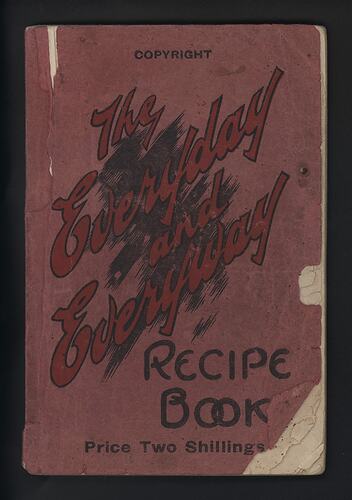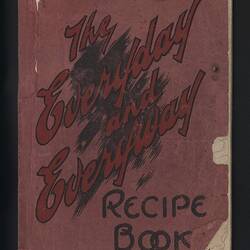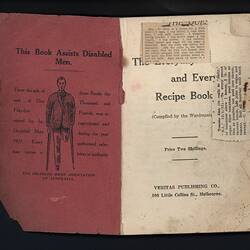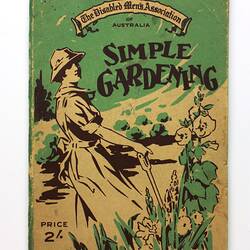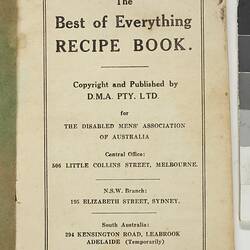Summary
64-page recipe book with red paper cover, titled 'The Everyday and Everyway Recipe Book'. 'Compiled by the Wardmaster' and published by Veritas Publishing Co. in 1925, the book was intended as a fundraiser for the Disabled Men's Association (DMA), which had been established that year. The Association was not specifically aimed at war veterans, but offered support for disabled men, whatever the cause of their disability.
The recipe book explains that 'All of the Recipes have been thoroughly TESTED AND TRIED. We have not filled page after page with advertisements, but devoted our full space to the recipes.' The recipes are simply and densely presented, with ingredients on continuous lines directly followed by instructions. Cooking knowledge is assumed - for instance, recipes are to be cooked in a 'slow' or 'moderate' oven, or sometimes no oven temperature is mentioned. Cooking times are not always given.
The final pages include general household recipes such as marble cleaning paste, rat eradicator (red colour to be added if made for sale) and liquid for washing and bleaching clothes. The last page of the book advertises Veritas Publishing's own 'Practical Prescriptions', and lists what can be treated.
The back cover provides information on the Disabled Mens' [sic] Association of Australia. Its objects are: 1. 'To discourage the indiscriminate applications for charity, by and on behalf of disabled men, by unauthorized collectors.' 2. 'To find suitable employment for permanently disabled men, irrespective of the origin or cause of disablement.' 3. 'Where it is impossible to obtain suitable employment for any member of the Association, owing to his disablement, the Association will endeavour, by the aid of its members and voluntary workers, to obtain a round of customers who will purchase household articles from him periodically, and so make him self-supporting.' The Association has no paid officials. Its secretariat is located at 10 St James' Buildings, Little Collins St, Melbourne. The recipe book was printed by Alliance Ptg Co, 43-47 Lonsdale St, Melbourne.
Around the same time, the DMA issued other publications including The "All in One" Recipe Book and Household Guide, Including Cooking, by Mrs. G. Vassal Cox (1927), Jams, Jellies, Marmalades: Selected and Tested Recipes and Formulas (1928), the Disabled Men's Association Gardening Book (SH 891373) and The Best of Everything Recipe Book, 1927 (HT 7512).
Physical Description
64-page book with red paper cover. Cover title in deeper red, set on angle and underlain by abstract swiped design. Inside cover is line drawing of a man with one leg missing, using crutches. Title above explains that 'This Book Assists Disabled Men'. 413 recipes follow, each numbered and divided into type: biscuits, buns, cakes, sandwiches, scones; icings; jams; jellies; marmalades; fruit preserves; condiments, pickles, chutneys; sauces; puddings; custards, sweets, etc; wines, cordials, beverages; and 'general household'. Inside cover has been pinned a recipe for tomato jam and a recipe for fruit cake. Both are secured with rusting pins.
Significance
This recipe book, and other publications of the Disabled Men's Association of Australia, reflects an important but little-discussed aspect of Australian society after World War I: tensions between disabled groups, particularly soldiers and non-soldiers. The Disabled Men's Association of Australia, established in 1925, ostensibly supported disabled men, whatever the cause of their disability. Its patrons included war hero Sir John Monash and Brigadier-General T. A. Blamey as well as civilians. However, some sources claim that the Association refused to support disabled ex-soldiers since they had been given a 'certain glamour' that the incapacitated civilian lacked, and therefore already had an advantage. Disabled civilians were 'deserving of a fuller sympathy, at least a deeper pity, for their need is as great as that of the bravest soldier. Do they not breathe the same air, buy in the same markets, have the same rents to pay? Many have met with their incapacity since marriage. Have they not homes and children to provide for? Is not theirs a greater need?' (Bruised Reeds, Disabled Men's Association of Australia, Melbourne, 1928, quoted by Bourke, 1998).
Complicating matters, disabled ex-soldiers frequently opposed each other as well. A veteran with a 'crook leg' complained against the favouritism shown to the limbless. ('Crook Leg', 'Correspondence. Tweed Industry', Diggers' Gazette, 15 December 1920, p. 49) Considerable time was spent debating how physically maimed a man had to be to join associations. (Joanna Bourke, 1998, 'The Battle of the Limbs: Amputation, Artificial Limbs and the Great War in Australia', Australian Historical Studies, 29:110, 49-67)
Although the provenance of this particular recipe book is unknown, it is significant that it has been used as intended, with additional recipes pinned to its front page. This suggests it functioned as a practical object as well as a fund-raiser.
More Information
-
Collecting Areas
Public Life & Institutions, Home & Community, Medicine & Health
-
Acquisition Information
Donation from Barbara Russell - Vintage Cookbooks, 12 Mar 2011
-
Other Association (See Comments)
Disabled Men's Association of Australia Pty Ltd, Australia, 1925
Published as a fund-raiser for. The secretariat of the Disabled Men's Association of Australia was located at 10 St James' Buildings, Little Collins St when this book was published. -
Printer
Alliance Printing Co., Lonsdale Street, Melbourne, Greater Melbourne, Victoria, Australia, circa 1926
-
Publisher
-
Inscriptions
Cover: 'COPYRIGHT / The Everyday / and / Everyway / RECIPE / BOOK / Price Two Shillings'. Inside cover: "This Book Assists Disabled / Men. / From the sale of these Books the / sum of One Thousand and / Fifty-five Pounds was re-/ceived by Incapacitated and / Disabled Men during the year / 1925. Every authorised sales-/man carries a letter of authority / THE DISABLED MENS' ASSOCIATION / OF AUSTRALIA'.
-
Classification
-
Category
-
Discipline
-
Type of item
-
Overall Dimensions
120 mm (Width), 10 mm (Depth), 180 mm (Height)
-
References
Joanna Bourke, 1998, 'The Battle of the Limbs: Amputation, Artificial Limbs and the Great War in Australia', Australian Historical Studies, 29:110, 49-67
-
Keywords
Cooking, Disability Organisations, Recipes, World War I, 1914-1918
